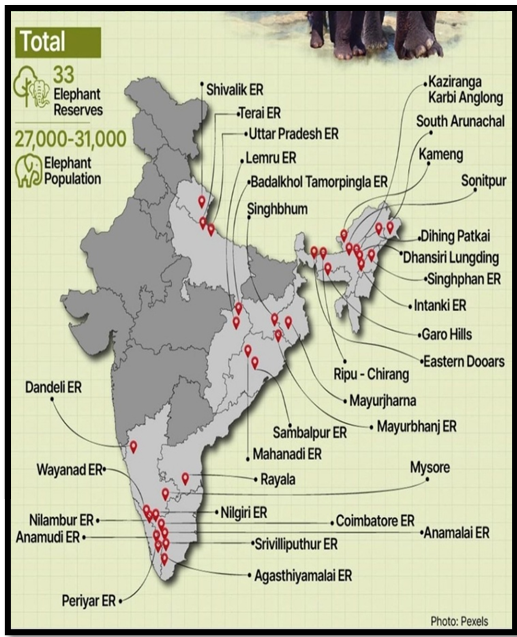WHERE HAVE THE ELEPHANTS GONE ?
Why in the News?
The precarious situation of elephants in and around Guwahati has become a pressing concern, highlighting the challenges in human-wildlife coexistence. The lopsided struggle for survival faced by these majestic creatures is a looming threat to Assam’s rich fauna.
Elephant Reserves in India

| Elephants in India:
· India’s Natural Heritage Animal · A “Keystone Species.” · India has Largest number of wild Asian Elephants globally (29,964). · About 60% of the species’ global population. · Top three states with elephant population: Karnataka, Assam, Kerala. · IUCN Status: Endangered (Asian Elephant – Elephas maximus). · Protected under Wildlife (Protection) Act, 1972: Schedule I. |
The Countdown to Doomsday
- Dwindling Fauna: Assam’s wildlife faces rapid depletion due to challenges in cohabiting with humans.
- Absence of Conservation Planning:
- Field-level officials reveal a lack of a “strength, weakness, opportunity, threat framework” essential for wildlife conservation planning in and around Guwahati.
- Despite boasting 11 reserve forests, there exists no written plan for the city’s wildlife management.
Elephant Fatalities: A Grim Reality
- Causes of Elephant Deaths:
- Over 40 elephants have succumbed to various causes in Assam over the past three years.
- Causes include: Poisoning; Electrocution; Illegal hunting, and Tragic train accidents.
- Train Accidents: A Silent Menace:
- Trains pose a significant threat, resulting in fatal collisions with elephants, especially in prime elephant habitats.
- Nighttime and poor visibility exacerbate the risks, with survival chances near-zero after a collision.
Encroachment: Another Battlefront
- Extent of Forest Encroachment:
- More than 4000 sq.km of reserve forest area in Assam is under encroachment.
- Disturbance to natural habitats forces elephants into human settlements, further intensifying the human-elephant conflict.
Reasons Behind Encroachment:
- Lack of political will, as highlighted by the Central Empowered Committee, contributes to rampant encroachment.
- 40% of reserve forests are encroached, with 90% of the encroachment attributed to dwelling purposes.
Ineffectiveness of Wildlife Division:
- Despite the formation of the Guwahati Wildlife Division in 2006, no comprehensive plan for urban wildlife management has been devised.
Urgent and strategic conservation efforts, backed by political will, are imperative to avert the impending crisis .




